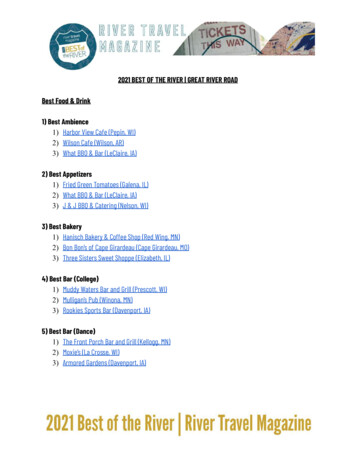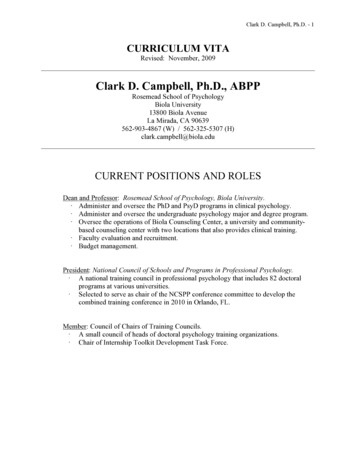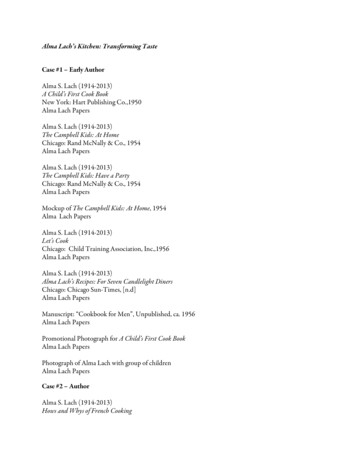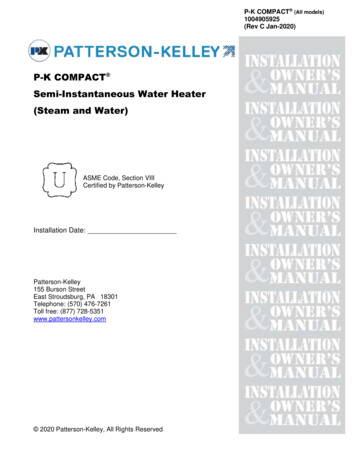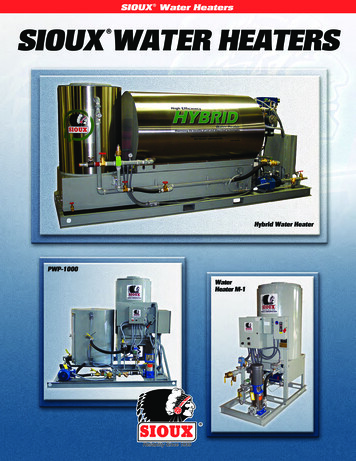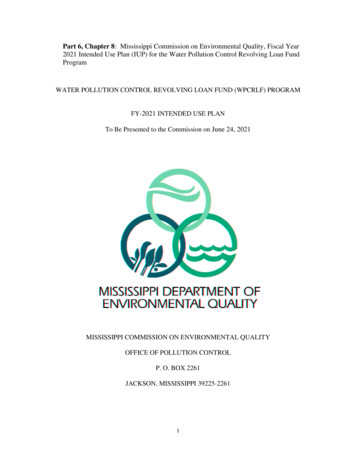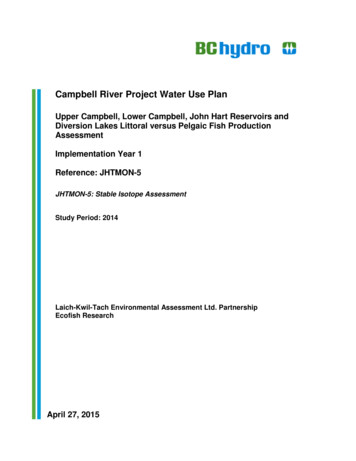
Transcription
Campbell River Project Water Use PlanUpper Campbell, Lower Campbell, John Hart Reservoirs andDiversion Lakes Littoral versus Pelgaic Fish ProductionAssessmentImplementation Year 1Reference: JHTMON-5JHTMON-5: Stable Isotope AssessmentStudy Period: 2014Laich-Kwil-Tach Environmental Assessment Ltd. PartnershipEcofish ResearchApril 27, 2015
JHTMON-5: Stable IsotopeAssessmentYear 1 Annual Monitoring ReportPrepared for:BC Hydro Water License Requirements6911 Southpoint Drive, 11th FloorBurnaby, BC, V3N 4X8April 27, 2015Prepared by:Morgan Hocking Ph.D., Arin Yeomans-Routledge B.Sc., R.P.Bio., Noel Swain M.Sc., MikeMarquardson R.B. Tech, John Abell Ph.D., and Todd Hatfield Ph.D., R.P.Bio1Laich-Kwil-Tach Environmental Assessment Ltd. PartnershipEcofish Research Ltd.1Certifying professional
JHTMON5 – Year 1 Annual Monitoring ReportPage iPhotographs and illustrations copyright 2015Published by Ecofish Research Ltd., Suite F, 450 8th St., Courtenay, B.C., V9N 1N5Citation:Hocking, M., A. Yeomans-Routledge, N. Swain, M. Marquardson, J. Abell, and T. Hatfield. 2015.JHTMON5 – Year 1 Annual Monitoring Report. Consultant’s report prepared for BCHydro by Laich-Kwil-Tech Environmental Assessment Ltd. Partnership and EcofishResearch Ltd, April 27, 2015.Certification:Certified: stamped version on fileTodd Hatfield, R. P. Bio. No. 927Disclaimer:This report was prepared by Ecofish Research Ltd. for the account of BC Hydro. The material in itreflects the best judgement of Ecofish Research Ltd. in light of the information available to it at thetime of preparation. Any use which a third party makes of this report, or any reliance on or decisionsto be made based on it, is the responsibility of such third parties. Ecofish Research Ltd. accepts noresponsibility for damages, if any, suffered by any third party as a result of decisions made oractions, based on this report. This numbered report is a controlled document. Any reproductions ofthis report are uncontrolled and may not be the most recent revision.1230-04
JHTMON5 – Year 1 Annual Monitoring ReportPage iiEXECUTIVE SUMMARYWater Use Plans (WUPs) were developed for all of BC Hydro’s hydroelectric facilities through aconsultative process and there is expected to be monitoring to address outstanding managementquestions in the years following the implementation of a WUP. As the Campbell River Water UsePlan process reached completion, a number of uncertainties remained with respect to the effects ofBC Hydro operations on aquatic resources. The Upper Campbell, Lower Campbell, John Hart Reservoirsand Diversion Lakes Littoral versus Pelagic Fish Production Assessment (JTHMON-5) is part of widermonitoring of the Campbell River WUP. JTHMON-5 is designed to assess the extent to which fishproduction is driven by littoral vs. pelagic production and how this relates to BC Hydro operations.The Campbell River WUP project area is complex and includes facilities and operations in theCampbell, Quinsam and Salmon watersheds. In addition to the mainstem rivers, there are three largereservoirs, nine diversion lakes influenced by water diverted from the Quinsam and Salmon rivers,and many tributaries and small lakes that are not directly affected by operations. Duringdevelopment of the Campbell River WUP, the Fish Technical Committee (FTC) hypothesized thatfish production in Upper and Lower Campbell reservoirs was negatively impacted by largefluctuations in water level through its effect on littoral production. The FTC also hypothesized thatshort water residence time of the diversion lakes as a result of the BC Hydro diversion operationscould negatively impact pelagic productivity.The JTHMON-5 monitoring program aims to address the following two management questions:1. To what extent do stabilized reservoir levels, as affected by BC hydro operations, benefit fishpopulations?2. What is the relationship between residence time (as affected by diversion rate) and lakeproductivity?The JHTMON-5 study is scheduled for 10 years with the first year as a pilot year to develop andconfirm the stable isotope methodology. Substantial information regarding the structure andfunctioning of lake food webs can be gained by using stable isotopes to reconstruct the diets of lakebiota. JHTMON-5 uses stable isotope analysis of nitrogen and carbon in fish tissues and theirpotential diet items to assess relative energy flows to fish from littoral vs. pelagic areas. Sampling wascompleted for Upper Campbell Reservoir, Gooseneck Lake, and Middle Quinsam Lake. UpperCampbell Reservoir was chosen because it experiences the greatest fluctuations in water levels.Gooseneck Lake and Middle Quinsam Lake were chosen because they are part of the QuinsamRiver diversion with Middle Quinsam experiencing greater water residence time (donor lake) andGooseneck experiencing reduced water residence time (recipient lake).The primary species of interest in JHTMON-5 are Cutthroat Trout (Oncorhynchus clarkii) andRainbow Trout (O. mykiss). Sampling was geared toward understanding the diets and energy sourcesof these two fish species, which are the resident fish species of primary management concern inreservoirs and lakes of the Campbell River system. Gill netting and minnow trapping was completed1230-04
JHTMON5 – Year 1 Annual Monitoring ReportPage iiiin August 2014 to obtain representative tissue samples from Cutthroat Trout, Rainbow Trout andtheir prey fish including Threespine Stickleback (Gasterosteus aculeatus), Sculpin spp. (Cottus spp.), andjuvenile trout (Oncorhynchus spp.) from Upper Campbell, Gooseneck and Middle Quinsam lakes.Primary diet items for Cutthroat Trout and Rainbow Trout also include zooplankton (pelagicsource), and benthic, stream and terrestrial invertebrates (littoral source). Invertebrate samplingoccurred in June, July and August to obtain representative samples from the three lakes.Invertebrates were sorted in the lab and identified to Order, Family or Genus.Invertebrate and fish samples were processed for nitrogen and carbon stable isotopes at the StableIsotope in Nature Laboratory located within the Canadian Rivers Institute at the University of NewBrunswick in Fredericton, New Brunswick. A total of 171 samples of invertebrates and fish weresent for analysis. The relative contributions of pelagic vs. littoral sources to Cutthroat Trout andRainbow Trout diets were assessed through dual isotope (δ13C and δ15N), four to seven-sourceBayesian isotopic mixing models implemented in the program SIAR (Stable Isotope Analysis in R).SIAR takes isotope data from consumers (fish) and sources (diet items) along with estimates of diet tissue isotopic fractionation, and fits Bayesian models that estimate source contributions to diet.Catch-per-unit-effort (CPUE), fork length and age data were obtained from fish sampling on eachlake. Average CPUE for Cutthroat Trout was 0.30 fish/net hour, 0.42 fish/net hour, and 2.42fish/net hour for Upper Campbell Reservoir, Gooseneck Lake, and Middle Quinsam Lake,respectively. CPUE for Rainbow Trout on the Upper Campbell Reservoir was 0.81 fish/net hour. InUpper Campbell Reservoir, the fork length of Cutthroat Trout ranged from 127 mm to 459 mm,while Rainbow Trout ranged from 92 mm to 302 mm. The fork length of Cutthroat Trout capturedin Gooseneck and Middle Quinsam lakes ranged from 132 mm to 286 mm and 132 mm to 329 mm,respectively. In Upper Campbell Reservoir, our subsample of Cutthroat Trout ranged in age fromone to seven years, and Rainbow Trout ranged in age from one to six years. Cutthroat Troutsampled from Gooseneck Lake were four to five years, while Cutthroat Trout from MiddleQuinsam Lake ranged in age from two to six yearsNitrogen and carbon stable isotope signatures of all fish and invertebrates were similar among allthree lakes. Large Cutthroat and Rainbow trout had the highest δ15N levels consistent with their topposition within lake food webs, followed by smaller prey fish with intermediate trophic levelpositions. Zooplankton had the lowest δ13C levels consistent with their pelagic habitat, whilebenthic, stream, and terrestrial invertebrates had higher δ13C isotopic signatures, consistent with theirterrestrial and benthic sources of carbon in diet. Among the small prey fish, Threespine Sticklebackhad the lowest δ13C levels indicative of a pelagic dominated diet.Nitrogen and carbon stable isotope signatures in bulk zooplankton varied by month of collection.Across all lakes, δ15N signatures in zooplankton were significantly higher in August compared toJune or July while δ13C signatures were significantly higher in both July and August compared toJune.1230-04
JHTMON5 – Year 1 Annual Monitoring ReportPage ivIn Upper Campbell Reservoir, the total littoral contribution to Cutthroat Trout and Rainbow Troutdiets was higher than from pelagic sources despite the large size of the reservoir and lake levels thatare highly variable. Consistent with their role as a top predator, Cutthroat Trout (age 2 ) diets inUpper Campbell Reservoir were dominated by prey fish species, in particular Sculpin, followed byjuvenile trout and Threespine Stickleback (40%, 19%, and 18% diet contributions respectively).Zooplankton and benthic, stream and terrestrial invertebrates each made up less than 7% toCutthroat Trout diet. In contrast, Rainbow Trout diets had a much higher prevalence ofzooplankton (28%) and Threespine Stickleback (24%) and less Sculpin and juvenile trout ( 11%) intheir diets. A total of 24% of the diet of Cutthroat Trout in Upper Campbell Reservoir is estimatedto be derived from pelagic sources while 76% is estimated to be derived from littoral sources. Incontrast, Rainbow Trout have an estimated pelagic contribution to diet of 45% and a littoralcontribution to diet of 55%. The similarity in food webs between the three lakes and thedependence on littoral resources hint that Cutthroat Trout in Upper Campbell Reservoir may have arelatively fixed dependence on littoral production with limited ability to switch to a pelagicdominated diet. Rainbow Trout appear to utilize more pelagic resources than Cutthroat Trout inUpper Campbell Reservoir. No Rainbow Trout were caught in the much smaller Gooseneck andMiddle Quinsam lakes.In Gooseneck and Middle Quinsam lakes, juvenile trout were the dominant source to CutthroatTrout diet (35% and 34% respectively). Zooplankton contributed little to Cutthroat Trout diet inMiddle Quinsam Lake (7%), but make up 21% of Cutthroat Trout diet in Gooseneck Lake. Littoralinvertebrates from each group (benthic, stream, terrestrial) contributed from 3% to 16% ofCutthroat Trout diet across both lakes. In Gooseneck Lake, a total of 27% of the diet of CutthroatTrout is estimated to be derived from pelagic sources while 73% is estimated derived from littoralsources. In Middle Quinsam Lake, at total of 18% of Cutthroat Trout diet is estimated to be derivedfrom pelagic sources and 82% from littoral sources. The original prediction was that water residencetime will be shorter in Gooseneck Lake (receiving lake) than Middle Quinsam Lake (donor lake),which could result in decreased zooplankton production. Our observations are opposite to thepredictions made by the FTC; a greater pelagic source of production (ultimately from plankton) inGooseneck Lake was observed in Cutthroat Trout diets compared to Middle Quinsam Lake. It isimportant to note that this contrast is only from two lakes.Recommendations for the use of the stable isotope method and future years of the program includethe following:1. Stable isotope analysis of nitrogen and carbon has been used successfully in this pilot year tounderstand the diets of species or functional groups in lake food webs, and ultimately toprovide estimates of total littoral and pelagic contributions to diets of adult Cutthroat Troutand Rainbow Trout. The stable isotope approach is recommended for future years of theprogram to address management questions posed in the TOR.1230-04
JHTMON5 – Year 1 Annual Monitoring ReportPage v2. The Bayesian mixing model used to estimate diet contributions to fish in Upper CampbellReservoir, Gooseneck Lake and Middle Quinsam Lake is scientifically sound. This approachis the current standard in scientific assessments to estimate target species’ diets from multiplediet sources (e.g., Semmens et al. 2009). The Bayesian mixing model approach is alsorecommended for future years of the program.3. The Bayesian mixing model may be sensitive to the diet-tissue fractionation estimate appliedin the model for both isotopes. In this study, the diet-tissue fractionation values used in themodels were 1.50 1.16 for δ13C and 2.79 1.46 for δ15N. These values come from theliterature and are average diet-tissue fractionation rates across several fish species and tissuetypes (Sweeting et al. 2007a, b). However, fractionation from fish diet to sampled tissue canvary depending on the fish species, tissue sampled (e.g., fin, muscle, whole fish) and the typeof diet (invertebrate or fish prey). In future years, analyses should include more specific diettissue fractionation rates for each species and tissue type and sensitivity analyses offractionation rates. For example, fin-specific or trout-specific diet-tissue fractionation ratescould be used after a thorough literature review.4. Zooplankton δ15N and δ13C both increased through the summer. We recommend that futuresampling continue to occur across three time periods during the spring and summer so thatthe isotopic variation in zooplankton is adequately represented.5. Upper Campbell Reservoir was sampled in the pilot year of JHTMON-5. In future years werecommend obtaining estimates of fish diets and sources of production in Lower CampbellReservoir and John Hart Reservoir. This will allow for a more direct test of managementquestion 1 because the three reservoirs have contrasting water level fluctuations associatedwith BC Hydro operations. Lower Campbell and John Hart reservoirs could be sampled inthe same year or in different years (Year 2, Year 3).6. The lake levels of the three reservoirs are monitored continuously by BC Hydro. Werecommend that a metric for the depth of reservoir drawdown be developed to compareacross the three reservoirs. BC Hydro also monitors the lake levels of Brewster Lake as partof JHTMON-10. We therefore recommend that Brewster Lake also be included in the set ofdiversion lakes to be sampled and that a metric for lake drawdown be developed forBrewster Lake to compare to the results generated in the reservoirs. This would increase thesample size for addressing hypotheses associated with management question 1; however, wenote that the final sample size is still expected to be small (n 4).7. Gooseneck and Middle Quinsam lakes were chosen because they have contrasting waterdiversion operations. Gooseneck Lake receives water from the Quinsam Diversion and ishypothesized to have lower lake water residence time and lower pelagic contribution to fishproduction than Middle Quinsam (the donor lake). This prediction is opposite to what wasobserved. Across the full program we recommend that as many diversion and control lakesbe sampled as possible within the available budget, and that for each lake an estimate of1230-04
JHTMON5 – Year 1 Annual Monitoring ReportPage viwater residence time be developed based on lake volume and hydrology. For example, it ispossible that Middle Quinsam Lake has a lower water residence time than Gooseneck Lakebased on its unique morphology and hydrology. A modest number of lakes could besampled over several years rather than in a single year. This would enable simple regressionmodels relating water residence time in each lake to % littoral or % pelagic contributions tofish diets (Figure 31). Operations from water diversions could then be integrated intopredictive models of how water inputs or extractions can change lake water residence time,lake productivity and food webs. This approach is consistent with the TOR, but represents aquantitative approach to answering the management questions rather than the qualitativeapproach described in the TOR.8. Initial findings using stable isotopes show similar lake food webs across Upper CampbellReservoir, Gooseneck Lake and Middle Quinsam Lake. These initial results hint that UpperCampbell Reservoir Cutthroat Trout may not be changing their diets to a pelagic-dominatedsource of production and, instead, maintain their dependence on littoral production. Incontrast, Rainbow Trout have greater pelagic contribution to diet than Cutthroat Trout inUpper Campbell Reservoir. However, it is important to confirm these results from at leasttwo more full years of data collection from all three reservoirs and three to four diversionlakes per year (including controls). The Terms of Reference for JHTMON-5 proposed thatafter the pilot year 1 full sampling take place in years 2, 5 and 10 of the program (BC Hydro2013). We recommend that two full years of sampling occur in years 2 and 3 of the programin order to maintain continuity of staff and methods, rather than in years 2 and 5 asenvisioned by the TOR. A third full year of sampling may not be necessary and should beevaluated at the end of Year 3.9. Zooplankton sampling was conducted in triplicate in each sampling period on each lake. Werecommend that all zooplankton samples be counted and weighed so an estimate ofzooplankton production could be made for each lake. For example, the mass of zooplanktonobtained could be divided by the volume of water pulled through the zooplankton net toderive an estimate of zooplankton biomass per m3. This is important because zooplanktonproduction could then be compared directly to estimates of lake water residence time.10. It is possible that Cutthroat Trout and Rainbow Trout diet could shift among pelagic vs.littoral sources of production as they grow and age. For example, a negative relationship wasobserved between Rainbow Trout fork length and δ13C in Upper Campbell Reservoir. Infuture years, if these relationships between δ13C and size or age are observed then werecommend that analyses of Cutthroat Trout or Rainbow Trout diets be split by age or sizeclasses. This could provide more specific information on the size and age classes of fishmost affected by operational changes.1230-04
JHTMON5 – Year 1 Annual Monitoring ReportPage viiTABLE OF CONTENTSEXECUTIVE SUMMARY . IILIST OF FIGURES . IXLIST OF TABLES . XIILIST OF MAPS. XIV1.INTRODUCTION . 11.1. BACKGROUND TO WATER USE PLANNING . 11.2. BC HYDRO INFRASTRUCTURE, OPERATIONS AND THE MONITORING CONTEXT . 11.2.1. Reservoirs . 11.2.2. Diversion Lakes . 21.3. MANAGEMENT QUESTIONS AND HYPOTHESES . 21.4. SCOPE OF THE JHTMON 5 STUDY . 31.4.1. Overview . 31.4.2. Summary of the Main Method to Test Management Questions . 31.4.3. Sampling in Pilot Season . 42.METHODS . 72.1. INVERTEBRATE SAMPLING. 72.1.1. Zooplankton . 72.1.2. Benthic Invertebrates . 92.1.3. Stream Invertebrates . 102.1.4. Terrestrial Invertebrates . 112.2. FISH SAMPLING . 142.2.1. Gill Netting. 142.2.2. Minnow Trapping. 152.2.3. Individual Fish Analysis . 162.2.4. Stomach Contents. 182.3. STABLE ISOTOPE DATA . 182.3.1. Stable Isotope Processing . 182.3.2. Assessing Fish Diet Using Mixing Models . 202.3.3. Correlations with Fish Size and Age . 20RESULTS . 213.3.1. INVERTEBRATE SAMPLING. 213.1.1. Zooplankton . 213.1.2. Benthic Invertebrates . 213.1.3. Stream Invertebrates . 221230-04
JHTMON5 – Year 1 Annual Monitoring ReportPage viii3.1.4. Terrestrial Invertebrates . 223.2. FISH SAMPLING . 283.2.1. Gill Netting. 283.2.2. Minnow trapping. 303.2.3. Individual Fish Analysis . 323.2.4. Stomach Contents. 413.3. STABLE ISOTOPE DATA . 413.3.1. Summary of Stable Isotope Signatures by Taxa . 413.3.2. Seasonal Variation in Zooplankton . 443.3.3. Assessing Fish Diet Using Mixing Models . 453.3.4. Correlations with Fish Size and Age . 523.4. ANALYSIS OF MANAGEMENT QUESTIONS . 543.4.1. Reservoir Levels and Benefits to Fish Populations . 543.4.2. Water Residence Time and Lake Productivity . 554.CONCLUSIONS . 554.1. RESERVOIR LEVELS AND BENEFITS TO FISH POPULATIONS . 554.2. WATER RESIDENCE TIME AND LAKE PRODUCTIVITY . 565.RECOMMENDATIONS . 565.1. METHODS . 565.2. RECOMMENDATIONS FOR FUTURE SAMPLING . 57REFERENCES . 60PROJECT MAPS. 621230-04
JHTMON5 – Year 1 Annual Monitoring ReportPage ixLIST OF FIGURESFigure 1.Conceptual framework for the interpretation of stable isotope analysis (SIA) data whereb) is the pre-treatment state, a) is dominance of a pelagic-derived energy in fish diet, andc) is dominance of benthos-derived energy in fish diet. . 4Figure 2.Zooplankton net. . 8Figure 3.Zooplankton samples prior to adding ethanol. Note high density of captured specimens. 8Figure 4.Ponar grab sampling for benthic invertebrates. . 9Figure 5.Drift net secured in the Quinsam River to sample benthic macroinvertebrates upstreamof Middle Quinsam Lake (background). .11Figure 6.Malaise trap deployed adjacent to the littoral site at Gooseneck Lake (left) and view ofthe sampling container at the end of the 2.5 hour deployment period. .12Figure 7.Retrieving a RISC standard gill net from a pelagic site on Gooseneck Lake. .15Figure 8.An example scale aged as a 2 fish with age annuli indicated with landmarks. The initiallandmark and landmark on the outer edge are not counted in the fish age. .18Figure 9.Catch-per-unit-effort (CPUE) during gill netting of captured Cutthroat Trout (CT),Rainbow Trout (RB), and Dolly Varden (DV) from the Upper Campbell, MiddleQuinsam, and Gooseneck lakes, 2014. .29Figure 10. Catch-per-unit-effort (CPUE) during gill netting of captured Coho Salmon (CO), PricklySculpin (CAS), and Threespine Stickleback (TSB) from the Upper Campbell, MiddleQuinsam, and Gooseneck lakes, 2014. .30Figure 11. Catch-per-unit-effort (CPUE) of Prickly Sculpin during minnow trapping from theUpper Campbell, Middle Quinsam, and Gooseneck lakes, 2014. .31Figure 12. Length-frequency histogram of Cutthroat Trout and Rainbow Trout captured in theUpper Campbell Reservoir in August, 2014. .33Figure 13. Length-frequency histogram of Cutthroat Trout captured in Gooseneck Lake in August,2014. .34Figure 14. Length-frequency histogram of Cutthroat Trout captured in Middle Quinsam Lake inAugust, 2014.35Figure 15. Length-weight regression for captured Cutthroat Trout and Rainbow Trout captured inthe Upper Campbell Reservoir in August, 2014. .36Figure 16. Length-weight regression for captured Cutthroat Trout captured in Gooseneck Lake inAugust, 2014.361230-04
JHTMON5 – Year 1 Annual Monitoring ReportPage xFigure 17. Length-weight regression for captured Cutthroat Trout captured in Middle QuinsamLake in August, 2014. .37Figure 18. Length at age for Cutthroat Trout and Rainbow Trout in Upper Campbell Reservoir,2014. .37Figure 19. Length at age for Cutthroat Trout in Gooseneck Lake, 2014. .38Figure 20. Length at age for Cutthroat Trout in Middle Quinsam Lake, 2014.38Figure 21. Carbon – nitrogen stable isotope bi-plots (mean SD) of fish and invertebrates fromUpper Campbell, Gooseneck, and Middle Quinsam lakes.42Figure 22. Average δ15N stable isotope signatures in all taxa sampled across all three lakes. ZOO Zooplan
Apr 27, 2015 · potential diet items to assess relative energy flows to fish from littoral vs. pelagic areas. Sampling was completed for Upper Campbell Reservoir, Gooseneck Lake, and Middle Quinsam Lake. Upper Campbell Reservoir was chosen because
